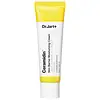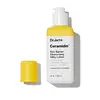What's inside
What's inside
 Key Ingredients
Key Ingredients

 Benefits
Benefits

 Concerns
Concerns

 Ingredients Side-by-side
Ingredients Side-by-side

Water
Skin ConditioningGlycerin
HumectantCaprylic/Capric Triglyceride
MaskingDipropylene Glycol
HumectantCetearyl Alcohol
EmollientHydrogenated Polydecene
EmollientMethyl Trimethicone
Skin ConditioningHydrogenated Poly(C6-14 Olefin)
EmollientButyrospermum Parkii Butter
Skin Conditioning1,2-Hexanediol
Skin ConditioningPhenyl Trimethicone
Skin ConditioningDicaprylyl Ether
EmollientCetearyl Olivate
Panthenol
Skin ConditioningGlyceryl Stearate
EmollientBehenyl Alcohol
EmollientSorbitan Olivate
EmulsifyingTheobroma Cacao Seed Extract
Antioxidant2,3-Butanediol
HumectantCetearyl Glucoside
EmulsifyingCeramide NP
Skin ConditioningCeramide Ng
Skin ConditioningCeramide Ns
Skin ConditioningCeramide As
Skin ConditioningCeramide AP
Skin ConditioningCholesterol
EmollientPentaerythrityl Distearate
EmulsifyingHydrogenated Lecithin
EmulsifyingPalmitic Acid
EmollientStearic Acid
CleansingMicrocrystalline Cellulose
AbsorbentGlyceryl Stearate Se
EmulsifyingAmmonium Acryloyldimethyltaurate/Vp Copolymer
Cellulose Gum
Emulsion StabilisingDextrin
AbsorbentGlyceryl Polymethacrylate
Pelargonium Graveolens Flower Oil
MaskingOlea Europaea Fruit Oil
MaskingCitrus Aurantium Bergamia Fruit Oil
MaskingSalvia Officinalis Oil
MaskingCitronellol
PerfumingTocopherol
AntioxidantCI 19140
Cosmetic ColorantWater, Glycerin, Caprylic/Capric Triglyceride, Dipropylene Glycol, Cetearyl Alcohol, Hydrogenated Polydecene, Methyl Trimethicone, Hydrogenated Poly(C6-14 Olefin), Butyrospermum Parkii Butter, 1,2-Hexanediol, Phenyl Trimethicone, Dicaprylyl Ether, Cetearyl Olivate, Panthenol, Glyceryl Stearate, Behenyl Alcohol, Sorbitan Olivate, Theobroma Cacao Seed Extract, 2,3-Butanediol, Cetearyl Glucoside, Ceramide NP, Ceramide Ng, Ceramide Ns, Ceramide As, Ceramide AP, Cholesterol, Pentaerythrityl Distearate, Hydrogenated Lecithin, Palmitic Acid, Stearic Acid, Microcrystalline Cellulose, Glyceryl Stearate Se, Ammonium Acryloyldimethyltaurate/Vp Copolymer, Cellulose Gum, Dextrin, Glyceryl Polymethacrylate, Pelargonium Graveolens Flower Oil, Olea Europaea Fruit Oil, Citrus Aurantium Bergamia Fruit Oil, Salvia Officinalis Oil, Citronellol, Tocopherol, CI 19140
Water
Skin ConditioningGlycerin
HumectantDicaprylyl Carbonate
EmollientOctyldodecanol
EmollientButylene Glycol
HumectantDiisostearyl Malate
EmollientPentylene Glycol
Skin ConditioningPanthenol
Skin ConditioningDiglycerin
HumectantVinyldimethicone
1,2-Hexanediol
Skin ConditioningCetearyl Olivate
Hydrogenated Vegetable Oil
EmollientSorbitol
HumectantCeramide NP
Skin ConditioningPolyglyceryl-3 Diisostearate
EmulsifyingTheobroma Cacao Extract
Skin ConditioningTromethamine
BufferingCetearyl Alcohol
EmollientCyclodextrin
AbsorbentSilica
AbrasiveHydroxyethyl Acrylate/Sodium Acryloyldimethyl Taurate Copolymer
Emulsion StabilisingSorbitan Olivate
EmulsifyingGlyceryl Stearate
EmollientAcrylates/C10-30 Alkyl Acrylate Crosspolymer
Emulsion StabilisingC12-16 Alcohols
EmollientPalmitic Acid
EmollientHydrogenated Lecithin
EmulsifyingLecithin
EmollientSorbitan Isostearate
EmulsifyingDextrin
AbsorbentParfum
MaskingSodium Phytate
Tocopherol
AntioxidantPhenoxyethanol
PreservativeCI 19140
Cosmetic ColorantWater, Glycerin, Dicaprylyl Carbonate, Octyldodecanol, Butylene Glycol, Diisostearyl Malate, Pentylene Glycol, Panthenol, Diglycerin, Vinyldimethicone, 1,2-Hexanediol, Cetearyl Olivate, Hydrogenated Vegetable Oil, Sorbitol, Ceramide NP, Polyglyceryl-3 Diisostearate, Theobroma Cacao Extract, Tromethamine, Cetearyl Alcohol, Cyclodextrin, Silica, Hydroxyethyl Acrylate/Sodium Acryloyldimethyl Taurate Copolymer, Sorbitan Olivate, Glyceryl Stearate, Acrylates/C10-30 Alkyl Acrylate Crosspolymer, C12-16 Alcohols, Palmitic Acid, Hydrogenated Lecithin, Lecithin, Sorbitan Isostearate, Dextrin, Parfum, Sodium Phytate, Tocopherol, Phenoxyethanol, CI 19140
 Reviews
Reviews

Ingredients Explained
These ingredients are found in both products.
Ingredients higher up in an ingredient list are typically present in a larger amount.
1,2-Hexanediol is a synthetic liquid and another multi-functional powerhouse.
It is a:
- Humectant, drawing moisture into the skin
- Emollient, helping to soften skin
- Solvent, dispersing and stabilizing formulas
- Preservative booster, enhancing the antimicrobial activity of other preservatives
Ceramide NP is a type of ceramide and formally known as ceramide 3.
Ceramides are intercellular lipids naturally found in our skin that bonds dead skin cells together to create a barrier. They are known for their ability to hold water and thus are a great ingredient for dry skin.
Ceramides are an important building block for our skin barrier. A stronger barrier helps the skin look more firm and hydrated. By bolstering the skin ceramides act as a barrier against irritating ingredients. This can help with inflammation as well.
If you would like to eat ceramides, sweet potatoes contain a small amount.
Read more about other common types of ceramides here:
Ceramide AP
Ceramide EOP
Cetearyl alcohol is a mixture of two fatty alcohols: cetyl alcohol and stearyl alcohol. It is mainly used as an emulsifier. Emulsifiers help prevent the separation of oils and products. Due to its composition, it can also be used to thicken a product or help create foam.
Cetearyl alcohol is an emollient. Emollients help soothe and hydrate the skin by trapping moisture.
Studies show Cetearyl alcohol is non-toxic and non-irritating. The FDA allows products labeled "alcohol-free" to have fatty alcohols.
This ingredient is usually derived from plant oils such as palm, vegetable, or coconut oils. There is debate on whether this ingredient will cause acne.
Due to the fatty acid base, this ingredient may not be Malassezia folliculitis safe.
Learn more about Cetearyl AlcoholCetearyl Olivate is an emulsifier and texture enhancer. It is derived from the fatty acids of olive oil and Cetearyl alcohol, and is biodegradable.
As an emulsifier, it is used to prevent oils and waters from separating. It can also
Manufacturers use the name Olivem 1000. This ingredient has been found to preserve the natural microbiome of skin. Having a healthy microbiome helps keep our skin healthy and protects against harmful bacteria. This ingredient is grouped with Sorbitan Olivate under the name Olivem 1000.
Learn more about Cetearyl OlivateCI 19140 is also known as Tartrazine. Tartrazine is a synthetic dye used in cosmetics, foods, and medicine to add a yellow color.
Tartrazine is created from petroleum and is water-soluble.
Some people may experience allergies from this dye, especially asthmatics and those with an aspirin intolerance.
Learn more about CI 19140Dextrin is used to thicken a product and helps bind ingredients together. It is created from starch and glycogen.
As an emulsifier, dextrin prevents ingredients from separating. This helps elongate a product's shelf life.
Studies show coating UV filters with dextrin prevents these ingredients from being absorbed. This helps UV ingredients last longer on the skin.
Learn more about DextrinGlycerin is already naturally found in your skin. It helps moisturize and protect your skin.
A study from 2016 found glycerin to be more effective as a humectant than AHAs and hyaluronic acid.
As a humectant, it helps the skin stay hydrated by pulling moisture to your skin. The low molecular weight of glycerin allows it to pull moisture into the deeper layers of your skin.
Hydrated skin improves your skin barrier; Your skin barrier helps protect against irritants and bacteria.
Glycerin has also been found to have antimicrobial and antiviral properties. Due to these properties, glycerin is often used in wound and burn treatments.
In cosmetics, glycerin is usually derived from plants such as soybean or palm. However, it can also be sourced from animals, such as tallow or animal fat.
This ingredient is organic, colorless, odorless, and non-toxic.
Glycerin is the name for this ingredient in American English. British English uses Glycerol/Glycerine.
Learn more about GlycerinGlyceryl Stearate is a mix of glycerin and stearic acid.
It is used to stabilize the mixing of water and oil ingredients. By preventing these ingredients from separating, it can help elongate shelf life. It can also help thicken the product's texture.
As an emollient, it helps soften skin and supports barrier-replenishing ingredients.
In cosmetics, Glyceryl Stearate is often made from vegetable oils or synthetically produced.
This ingredient may not be fungal-acne safe
Fun fact: The human body also creates Glyceryl Stearate naturally.
Learn more about Glyceryl StearateHydrogenated Lecithin is created from the hydrogenation of lecithin (a group of phospholipids). Hydrogenation is a chemical reaction between hydrogen and another element.
This ingredient is an emollient and emulsifier. As an emollient, it helps soften skin by trapping moisture within. As an emulsifier, it prevents oil and water ingredients from separating.
Palmitic Acid is a fatty acid naturally found in our skin and in many plant and animal sources. In cosmetics, it is usually derived from palm oil. It serves many purposes in skincare, acting as a cleanser, emollient, and emulsifier.
As an emollient, palmitic acid helps soften and smooth the skin by preventing water loss. In cleansers, it helps remove oil and dirt while creating foam.
Its emulsifying properties help stabilize products by keeping water and oil-based ingredients from separating.
This may not be suitable for fungal acne-prone skin, as fatty acids like this can sometimes trigger breakouts in sensitive individuals.
Learn more about Palmitic AcidPanthenol is a common ingredient that helps hydrate and soothe the skin. It is found naturally in our skin and hair.
There are two forms of panthenol: D and L.
D-panthenol is also known as dexpanthenol. Most cosmetics use dexpanthenol or a mixture of D and L-panthenol.
Panthenol is famous due to its ability to go deeper into the skin's layers. Using this ingredient has numerous pros (and no cons):
Like hyaluronic acid, panthenol is a humectant. Humectants are able to bind and hold large amounts of water to keep skin hydrated.
This ingredient works well for wound healing. It works by increasing tissue in the wound and helps close open wounds.
Once oxidized, panthenol converts to pantothenic acid. Panthothenic acid is found in all living cells.
This ingredient is also referred to as pro-vitamin B5.
Learn more about PanthenolSorbitan Olivate is created from the fatty acids in olive oil and sorbitol.
This ingredient is an oil in water emulsifier. It helps stabilize a product by preventing oils and waters from separating. Sorbitan Olivate also helps hydrate the skin.
Manufacturers sell sorbitan olivate under the name OliveM 1000. OliveM 1000 a multifunctional ingredient. It is self-emulsifying. According to a manufacturer, OliveM 1000 does not disrupt natural skin biome.
Due to its olive oil base, this ingredient may not be fungal-acne safe.
Learn more about Sorbitan OlivateTocopherol (also known as Vitamin E) is a common antioxidant used to help protect the skin from free-radicals and strengthen the skin barrier. It's also fat soluble - this means our skin is great at absorbing it.
Vitamin E also helps keep your natural skin lipids healthy. Your lipid skin barrier naturally consists of lipids, ceramides, and fatty acids. Vitamin E offers extra protection for your skin’s lipid barrier, keeping your skin healthy and nourished.
Another benefit is a bit of UV protection. Vitamin E helps reduce the damage caused by UVB rays. (It should not replace your sunscreen). Combining it with Vitamin C can decrease sunburned cells and hyperpigmentation after UV exposure.
You might have noticed Vitamin E + C often paired together. This is because it is great at stabilizing Vitamin C. Using the two together helps increase the effectiveness of both ingredients.
There are often claims that Vitamin E can reduce/prevent scarring, but these claims haven't been confirmed by scientific research.
Learn more about TocopherolWater. It's the most common cosmetic ingredient of all. You'll usually see it at the top of ingredient lists, meaning that it makes up the largest part of the product.
So why is it so popular? Water most often acts as a solvent - this means that it helps dissolve other ingredients into the formulation.
You'll also recognize water as that liquid we all need to stay alive. If you see this, drink a glass of water. Stay hydrated!
Learn more about Water